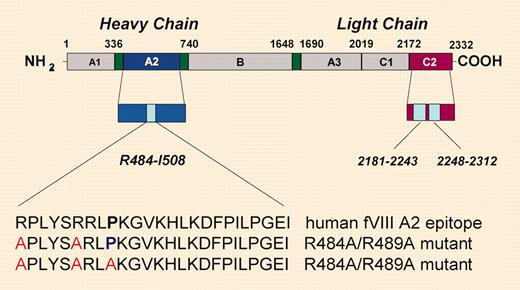Comment on Parker et al, page 704
Mutagenesis of an epitope within the A2 domain of fVIII not only reduces reactivity with inhibitory antibodies, but also decreases in vivo immunogenicity of human fVIII in hemophilic mice.
Efforts to identify epitopes to which factor VIII (fVIII) inhibitors are directed and to reduce inhibitor titers via tolerance induction or modification of fVIII domains have long been goals of hemophilia researchers. In the current issue of Blood, Parker and colleagues in the Lollar group at Emory demonstrate that mutagenesis of the immunodominant B-cell epitope within the A2 domain of fVIII reduced immunogenicity of human B-domain–deleted fVIII in hemophilic mice while retaining procoagulant activity.FIG1
Domain structure of factor VIII and location of major inhibitor epitopes. See a related figure in the article beginning on page 704.
Domain structure of factor VIII and location of major inhibitor epitopes. See a related figure in the article beginning on page 704.
The antibody response to fVIII is fascinating from an immunologic point of view and problematic from a clinical standpoint. Not only do 25% to 30% of hemophilia A patients make antibodies to fVIII that inhibit clotting activity (“inhibitors”), but healthy humans who are fVIII sufficient can develop acquired hemophilia due to the immune response to fVIII.1 Experimentally, the immune response to soluble proteins is weak and requires additional costimulation provided, for example, by adjuvants or inflammatory agents that activate Toll receptors. Without this second “danger” signal, the usual result is tolerance, not immunity. Factor VIII is different. It is immunogenic per se. Indeed, normal mice can make high-titer inhibitors after intravenous injections of therapeutic doses of fVIII in saline (L. Jin, N. Soukhareva, and D.W.S., unpublished data, 2004).
The fact that hemophilia A patients develop antibodies to fVIII is understandable, given their deficiency in fVIII (< 1% normal values) and presumptive lack of tolerance to epitopes in fVIII domains. Strikingly, most of these antibodies do not adversely affect fVIII clotting activity and are therefore not inhibitors. Those directed against either the C2 or the A2 domains of fVIII represent the vast majority of inhibitors due to the sequences in these domains required for initiation of clotting via fVIII interaction with von Willebrand factor (VWF), phospholipid membranes, enzyme fIXa, physiologic activator fXa, or clearance receptor lipoprotein receptor-related protein (LRP). Importantly, a major A2 epitope R484-I508 identified by the Scandella and Lollar groups2 resides in the region that interacts with fIXa and LRP. It was later shown that substitution of this human A2 region with a porcine sequence led to fVIII hybrid molecules with significantly reduced reactivity to a panel of hemophilia inhibitors,3 suggesting utility of this approach in patients with inhibitors.
In the current issue, Parker et al show that R484A/R489A/P492A mutant recombinant fVIII was significantly less immunogenic in fVIII knockout mice that are used as a model for hemophilia inhibitor formation. The P492A mutation proved to be critical for this reduced immunogenicity, as the R484A/R489A mutant molecules retained the ability to induce strong inhibitor responses. Importantly, the R484A/R489A/P492A mutant had similar coagulant and hemostatic activity and in vivo clearance as normal human B-domain–deleted fVIII.
The authors argue that the loss of structural constraints associated with P492 mutation may reduce fVIII immunogenicity via altering B-cell receptor–dependent antigen recognition. This mutation could also affect a T-cell epitope in that region, albeit this alone is less likely to reduce immunogenicity of such a large molecule as fVIII. The fact that inhibitor titers are not eliminated but only reduced may be due to the importance of the C2 domain, which clearly contains both B and T-cell epitopes recognized both in patients and in fVIII-deficient mice4 (Pratt et al, submitted). Whether the mutant A2 molecules will prove more effective at tolerance induction per se remains to be investigated. A combination of these mutations with alterations of fVIII domains that lead to prolongation of its lifetime in vivo5 offers promise for future inhibitor therapies. Since Stoilova-McPhie et al6 have resolved the 3-dimensional (3D) structure of membrane-bound fVIII, the current studies may provide further insight into fVIII immunodominance.


This feature is available to Subscribers Only
Sign In or Create an Account Close Modal